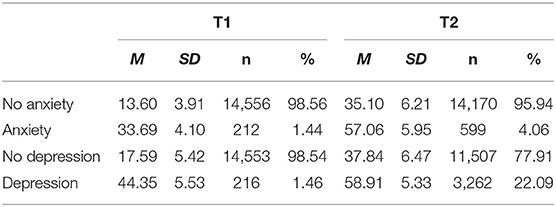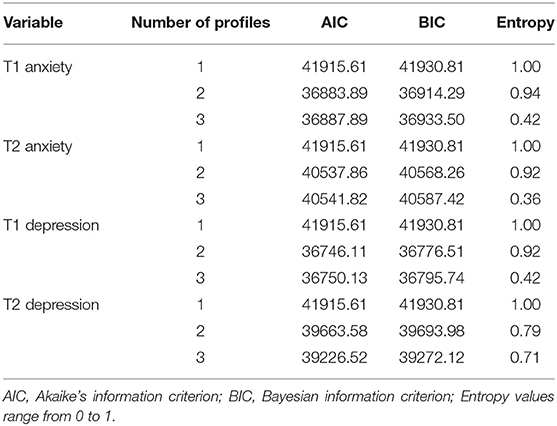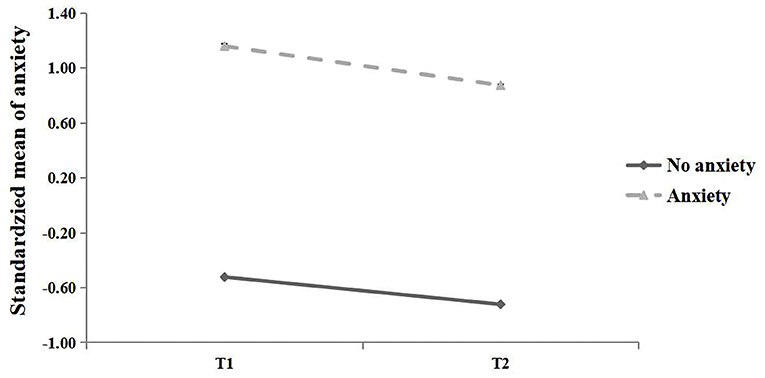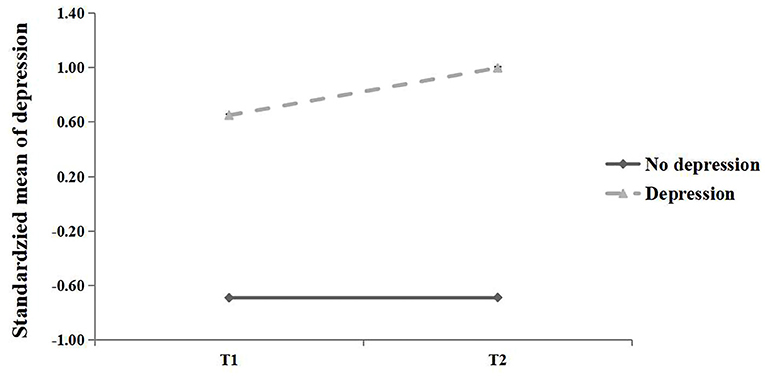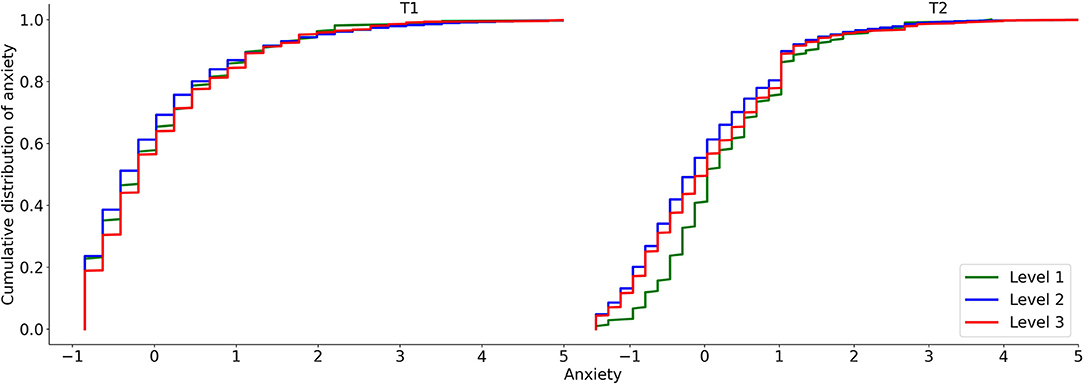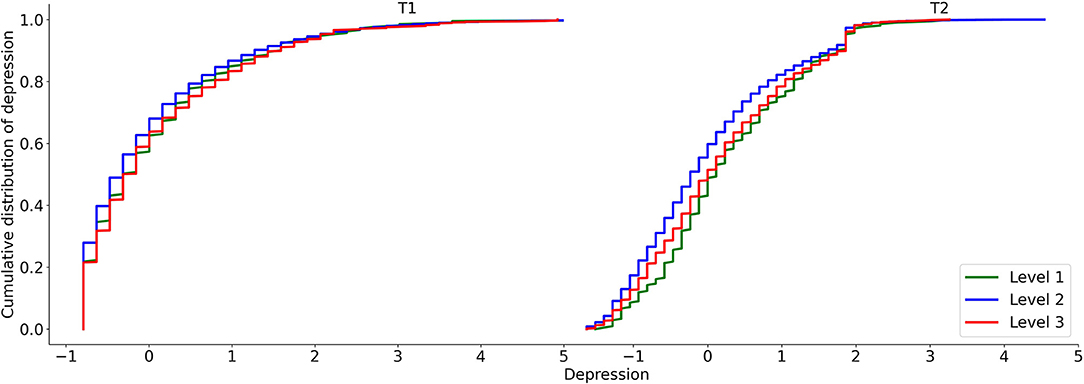- 1Student Counselling and Mental Health Center, Qingdao University, Qingdao, China
- 2Department of Psychology, Normal College, Qingdao University, Qingdao, China
- 3Department of Psychology, University of Southern Maine, Portland, ME, United States
- 4Department of Psychology, School of Social Science, The University of Manchester, Manchester, United Kingdom
Although accumulating evidence suggests the COVID-19 pandemic is associated with costs in mental health, the development of students' mental health, including the change from their previous levels of depression and anxiety and the factors associated with this change, has not been well-studied. The present study investigates changes in students' anxiety and depression from before the pandemic to during the lockdown and identifies factors that are associated with these changes. 14,769 university students participated in a longitudinal study with two time points with a 6-month interval. Students completed the Anxiety and Depression subscales of the Symptom Checklist 90 (SCL-90) before the COVID-19 outbreak (October 2020, Time 1), and the Self-rating Anxiety Scale (SAS) and Self-rating Depression Scale (SDS) during the pandemic (April 2020, Time 2). The prevalence of anxiety and depression symptoms were 1.44 and 1.46% at Time 1, and 4.06 and 22.09% at Time 2, respectively, showing a 181.94% increase in anxiety and a 1413.01% increase in depression. Furthermore, the increases in anxiety and depression from pre-pandemic levels were associated with students' gender and the severity of the pandemic in the province where they resided. This study contributes to the gap in knowledge regarding changes in students' mental health in response to the pandemic and the role of local factors in these changes. Implications for gender and the Typhoon Eye effect are discussed.
Introduction
The COVID-19 global pandemic caused a large number of infections and deaths (Cucinotta and Vanelli, 2020). To contain the virus, China initiated a series of emergency management steps at the beginning of March 2020, including shutting down schools and initiating online learning for close to 30 million university students across the country (i.e., Suspending Classes without Stopping Learning, http://www.moe.gov.cn/). Researchers around the world have called for researchers to examine the impact of the pandemic and school closures on students' anxiety, depression, and other outcomes (Holmes et al., 2020). Research suggests that the combined psychological pressure caused by the pandemic and the quarantine heightened anxiety and depression, particularly among university students (e.g., Brooks et al., 2020; Peng et al., 2020; Zhang et al., 2021).
Research around the world has reported high prevalence rates of anxiety and depression symptoms during the COVID-19 outbreak (Ahmed et al., 2020; Peng et al., 2020; Xiong et al., 2020). In a survey conducted from January 31 to February 3, 2020, nearly 30% of university students reported anxiety symptoms and more than 20% reported depression symptoms (Chang et al., 2020). A systematic review and meta-analysis conducted by Salari et al. (2020) estimated that the worldwide prevalence of anxiety and depression in the general population after the outbreak of COVID-19 was 31.9 and 33.7%, respectively. The costs of this heightened anxiety and depression for students are manifold, including impacts on students' thinking, motivation, interpersonal communication, and physical health; and could lead to sleep disturbances, loss of appetite, and even self-harm (e.g., Ystgaard et al., 1999; Gotlib and Hammen, 2008; Felger et al., 2015; Oxford, 2015).
Research conducted early in the pandemic suggested that individuals' level of anxiety and depression may be related to the province where they lived, and especially to the number of confirmed cases in the city (e.g., Ho et al., 2020; Xiong et al., 2020; Zhao et al., 2020). Past theorizing on the psychological effects of proximity to disaster offers predictions about how individuals' residence should impact their psychological well-being. Based on the impact of the Wenchuan earthquake on individuals' concerns about safety and health, Li et al. (2009, 2010) coined the term “Psychological Typhoon Eye” effect. This term refers to a pattern—like being in the eye of a storm—in which individuals who are closest to the center of the devastated area paradoxically show the least damaging psychological effects (Li et al., 2009, 2010). This pattern of results has been observed in negative correlations between schoolchildren's proximity to Ground Zero following the 9–11 attacks and their psychological well-being (Hoven et al., 2005) and between the level of exposure to SARS and anxiety (Xie et al., 2011). Zhang et al. (2020) found support for the Typhoon Eye effect in individuals' psychological responses to the COVID-19 pandemic, showing a negative correlation between the exposure level in 31 provinces in China and reported cases of mental health problems. However, others have found contradictory results. Zhao et al. (2020) reported that people who lived in high epidemic areas (provinces with more than 800 confirmed cases before Feb. 6, 2020) showed greater increases in anxiety from a baseline measure than those in low epidemic areas (i.e., other provinces in mainland China). Thus, in the present study we enter this debate by examining the relationship between the severity of the epidemic in the provinces where university students live (while completing classes remotely) and their anxiety and depression, controlling for their pre-pandemic levels.
A second factor that may influence anxiety and depression during the COVID-19 pandemic is gender (Ben-Ezra et al., 2020; Duan et al., 2020; Tang et al., 2020). Previous studies have found significant gender differences in anxiety and depression levels during the pandemic (Elbay et al., 2020; Mazza et al., 2020). A systematic review and meta-analysis found women suffered more severe anxiety and depression symptoms than men during the COVID-19 epidemic (Salari et al., 2020). Zhu et al. (2020), on the other hand, reported that males were more likely to experience depression in response to the pandemic. Other studies have found no significant differences in anxiety and depression levels between men and women (Chi et al., 2020; Van Rheenen et al., 2020). Therefore, this study will test how gender influences the development of anxiety and depression among college students in response to the COVID-19 epidemic, from before the start of the pandemic to during the lockdown. We further explore demographic factors previously known to be risk factors for anxiety and depression among college students, including economic status and medical conditions (e.g., Eisenberg et al., 2007; Xiong et al., 2020; Xu et al., 2020; Zhao et al., 2020).
In sum, our study has two aims. Using a longitudinal design, we first estimate the changes in anxiety and depression experienced by students from before the pandemic to during lockdown. Second, we examine whether the level of epidemic severity in students' geographic location, along with demographic variables like gender, economic status, and medical status, impact the change observed in anxiety and depression during the pandemic, as a test of the Typhoon Eye effect.
Method
Ethical Statement
This study complied with the ethical standards of the Declaration of Helsinki. All procedures were approved by our university's Research Ethics Committee. All participants willingly gave their informed consent to participate after being informed about the purpose of the study. All analyses were based on anonymous data.
Participants and Design
Longitudinal data were collected via a Chinese online research panel, Wenjuanxing (https://www.wjx.cn/). Twenty-four thousand six hundred ninety-six university students participated in Time 1 (T1) assessment, and 14,769 of these participants took part in the Time 2 (T2) assessment (8,060 female, 6,709 male), with a 40.14% attrition rate. Anxiety and depression did not differ between those who completed the second assessment and those who did not. The age of participants ranged from 17 to 34 years (M = 20.76, SD = 1.97).
T1 took place in October 2019 (before the COVID-19 outbreak) and T2 took place in April 2020 (when students were completing remote learning from home due to the pandemic). Both T1 and T2 focused on students' anxiety and depression. Different instruments for anxiety and depression were used at the two time points.
Measures
Anxiety and Depression of Symptom Checklist 90 (SCL-90)
We applied the subscale of the SCL-90 (Derogatis et al., 1973; Wang, 1984) to assess anxiety and depression in T1, which contains 10 items and 13 items, respectively. The items were rated along a 5-point response scale with 1-5 representing the severity as follows: “1 = no”, “2 = light”, “3 = moderate,” “4 = quite heavy,” and “5 = severe.” A standardized scoring algorithm is used to define anxiety symptoms, with a total score range of 10–50. Individuals were categorized as experiencing anxiety symptoms if the anxiety subscale score was >20. A standardized scoring algorithm was similarly used to define depression symptoms, with a total score range of 13–65. Individuals were categorized as experiencing depression symptoms if the depression subscale score was >26. The anxiety and depression subscales were internally consistent (Cronbach's αt1 = 0.85 and 0.89, respectively).
Zung Self-Rating Anxiety Scale
Anxiety at T2 was measured by the Chinese version of the SAS (Zung, 1971; Wu, 1999). The scale covers both psychological (e.g., “I feel afraid for no reason at all”) and somatic (e.g., “My arms and legs shake and tremble”) aspects of participants' anxiety symptoms. The items were rated along a 4-point response scale ranging from 1 (a little of the time) to 4 (most of the time). A standardized scoring algorithm is used to define anxiety symptoms, with a total score range of 25–100. Individuals were categorized as experiencing anxiety symptoms if the SAS score was greater than or equal to 50. The scale was internally consistent (Cronbach's α = 0.77).
Zung Self-Rating Depression Scale
Depression at T2 was measured by the Chinese version of SDS (Zung, 1965; Shu, 1999). It contains 20 items (e.g., “I have trouble sleeping at night,” “I get tired for no reason”) based on the diagnostic criteria of depression. Participants responded using a 4-point Likert scale ranging from 1 (a little of the time) to 4 (most of the time). A standardized scoring algorithm was used to define depression symptoms, with a total score range of 25–100. Individuals were categorized as experiencing depression symptoms if the SDS score was greater than or equal to 50. The scale was internally consistent (Cronbach's α = 0.86).
Epidemic Area
The epidemic area was defined as the cumulative number of confirmed cases in the province through the end of April 2020. Areas with 1–99 confirmed cases were labeled low (Level 1), areas with 100–999 confirmed cases were labeled middle (Level 2), and areas with more than 1,000 confirmed cases were labeled high epidemic areas (Level 3).
Demographics
Demographics included general demographic variables and economic status. The general demographic variables included gender and age. The economic status-related variables included per capita disposable income, per capita consumption expenditure, and the general public healthcare budget of each province. The data used was retrieved from the 2019 China Statistical Yearbook, which was published by China Statistics Press (http://www.stats.gov.cn/tjsj/ndsj/2019/indexch.htm).
Data Analysis
The statistical analyses were performed using SPSS Version 25.0 and Python. The stats. ks_2samp method was used to test the distribution of variables (Hodges, 1958; The Scipy Community, 2020). The 95% bias-corrected confidence interval (95% CI) was set, and the statistical significance level was set at p < 0.05. Latent profile analyses (LPA) were conducted in R (version 4.10.1) using the package tidyLPA, dplyr, and tidyverse to classify anxiety and depression in T1 and T2. Akaike information criterion (AIC), Bayesian information criterion (BIC), and entropy (range from 0 to 1) were applied as criteria (Schwarz, 1978; Akaike, 1987). Lower AIC and BIC values indicate better model fit, while higher entropy values indicate greater certainty.
Results
Common Method Biases
All the participant variables involved in this study were collected by online questionnaire, and a Harman single-factor test was used to diagnose the common method bias (Podsakoff et al., 2003). The results of principal component factor analysis without rotation showed that there were 22 factors whose eigenvalues were >1. The variance explained by the first factor was 20.15%, which falls below the threshold of 40%. This result indicates that there is no serious common method bias in this study.
Descriptive Statistics and Correlations
The descriptive results for anxiety and depression are shown in Table 1. The prevalence rate of anxiety and depression symptoms were 1.44 and 1.46% at T1, and 4.06 and 22.09% at T2, respectively, which represented a 181.94% increase in anxiety and a 1413.01% increase in depression.
A latent profile analysis (LPA) was conducted to explore anxiety and depression as categorical variables. The LPA results indicated that two profiles of anxiety and depression can be best distinguished with best class model fittings (Table 2). Figure 1 presents the standardized mean of anxiety of two profiles at T1 and T2. Profile 1 was characterized by significantly lower mean cores than Profile 2 at both time points, and were thus labeled no anxiety and anxiety, respectively. Figure 2 presents the standardized mean of depression of two profiles at T1 and T2. Profile 1 was characterized by significantly lower mean cores than Profile 2 at both time points, and were thus labeled no depression and depression, respectively.
Pearson correlations between variables are displayed in Table 3. Anxiety and depression were correlated with each other at T1 (r = 0.83, p < 0.01) and at T2 (r = 0.73, p < 0.01). Per capita disposable income and per capita consumption expenditure were negatively correlated with anxiety and depression at T1 and T2 (rs = −0.08 ~ −0.04, ps < 0.01). General public healthcare budget was negatively correlated with T2 anxiety (r = −0.02, p < 0.01). Men reported lower levels of depression than women at T1 (t = 3.23, p < 0.01) and higher levels of anxiety than women at T2 (t = −4.97, p < 0.001).
Anxiety
All continuous variables were standardized in the repeated analysis. The results indicated that students reported higher levels of anxiety at T2 than T1 (β = 0.080, F = 5.95, p < 0.05, 95% CI [0.016, 0.144]), with significantly different distributions of anxiety (Kolmogorov-Smirnov test; Z = 0.198, p < 0.001).
The effect of time on anxiety was significantly moderated by epidemic area level (F = 3.67, p < 0.05; Figure 3). In line with the Typhoon Eye effect, the mean increase in anxiety from T1 to T2 was significantly lower in the areas with the highest severity level (MD(T2−T1) = 0.004, p = 0.682, 95% CI [−0.017, 0.025]) than the increase among those in the lowest severity areas (MD(T2−T1) = 0.229, p < 0.01, 95% CI [0.060, 0.398]), qualified by significantly different distribution at T2 (Kolmogorov-Smirnov test; Z = 0.15, p < 0.001; Figure 4), and not significantly different from areas with a moderate severity level (MD(T2−T1) = 0.016, p = 0.730, 95% CI [−0.074, 0.106]).
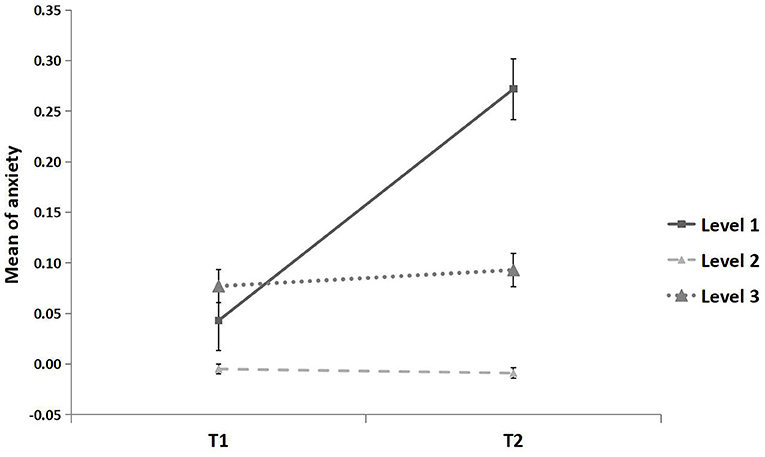
Figure 3. Mean of anxiety for three epidemic areas. All continuous variables were standardized. The epidemic area was defined as the cumulative number of confirmed cases in each province until the end of April 2020, i.e., low epidemic area (level 1): 1–99 cases, middle epidemic area (level 2): 100–999 cases, high epidemic area (level 3): ≥1,000 cases. Error bar is the standard error.
The effect of gender on anxiety was significantly moderated by time (F = 30.35, p < 0.001; Figure 5). At T1, no gender differences in anxiety were found (t = 1.85, p = 0.06). At T2, males reported significantly higher anxiety than females (β = 0.082, p < 0.001, 95% CI [0.050, 0.114]).
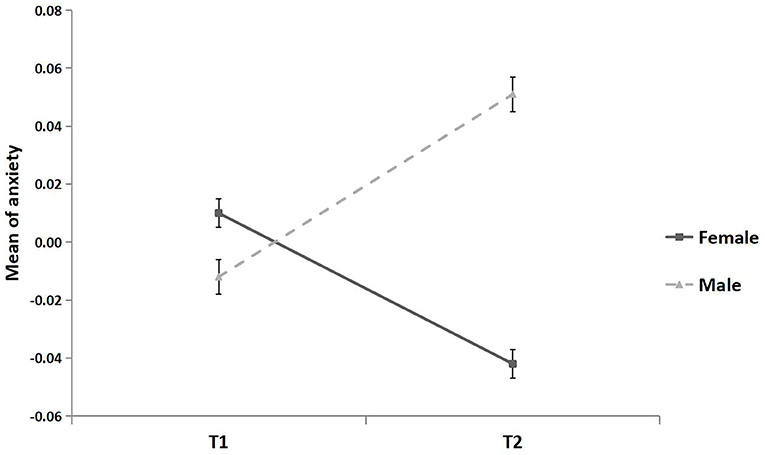
Figure 5. Mean of anxiety for females and males. All continuous variables were standardized. Error bar is the standard error.
We used logistic regression to assess the effects of T1 anxiety, T1 depression, epidemic level of the area, economic-related variables, and gender on T2 anxiety (Table 4). T1 anxiety (profile 1: no anxiety = 0; profile 2: anxiety = 1), T1 depression (profile 1: no depression = 0; profile 2: depression = 1), T2 anxiety (profile 1: no anxiety = 0; profile 2: anxiety = 1), the gender (male = 1, female = 0), and epidemic area (comparing Level 1 vs. Level 3 [Level 1_3]: Level 1 = 1, level 3 = 0; comparing Level 2 vs. Level 3 [Level 2_3]: Level 2 = 1, Level 3 = 0) were dummy coded. The regression model was significant, [F(8, 14760) = 55.73, p < 0.001, R2 = 0.029]. The regression coefficients of T1 anxiety (β = 0.083, t = 7.94, p < 0.001), T1 depression (β = 0.096, t = 0.93, p < 0.001), gender (β = 0.044, t = 5.39, p < 0.001), per capita consumption (β = −0.022, t = −4.20, p < 0.001) and Level 1 vs. 3 (β = 0.081, t = 2.04, p < 0.05) were significant.
Depression
All continuous variables were standardized in the repeated analysis. The results showed that students were more depressed at T2 than T1 (β = 0.075, F = 5.35, p < 0.05, 95% CI [0.11, 0.138]), with significantly different distributions of depression (Kolmogorov-Smirnov test; Z = 0.265, p < 0.001).
The effect of time on depression was significantly moderated by the area epidemic level (F = 2.98, p = 0.05; see Figure 6). Again, in line with the Typhoon Eye effect, the mean increase in depression from T1 to T2 was significantly lower in the areas with the highest severity level (MD(T2−T1) = 0.051, p = 0.264, 95% CI [−0.038, 0.139]) than the increase in the lowest severity level (MD(T2−T1) = 0.179, p < 0.05, 95% CI [0.012, 0.345]), although this was not significant in term of distribution (Kolmogorov-Smirnov test; Z = 0.08, p = 0.20; Figure 7), and was not significantly different from areas with a moderate severity level (MD(T2−T1) = −0.005, p = 0.603, 95% CI [−0.026, 0.015]).
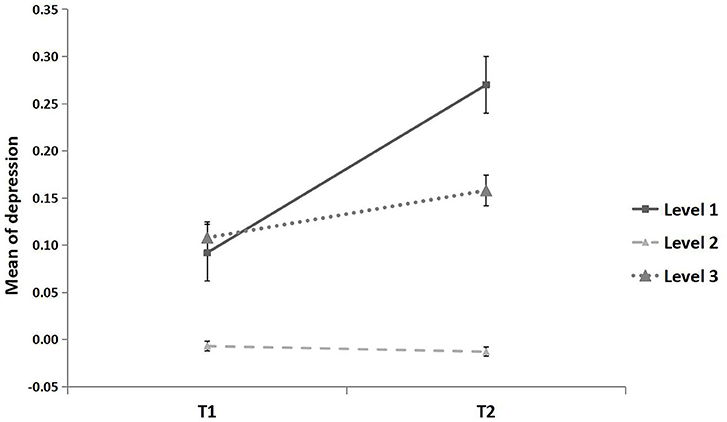
Figure 6. Mean of depression for three epidemic areas. All continuous variables were standardized. The epidemic area was defined as the cumulative number of confirmed cases in each province until the end of April 2020, i.e., low epidemic area (level 1): 1–99 cases, middle epidemic area (level 2): 100–999 cases, high epidemic area (level 3): ≥1,000 cases. Error bar is the standard error.
The effect of gender on depression was significantly moderated by time (F = 10.52, p < 0.001; see Figure 8). At T1, females reported higher levels of depression than males (β = 0.054, p < 0.005, 95% CI [0.021, 0.086]). At T2, the mean levels of depression did not differ between male and female (t = −0.64, p = 0.52).
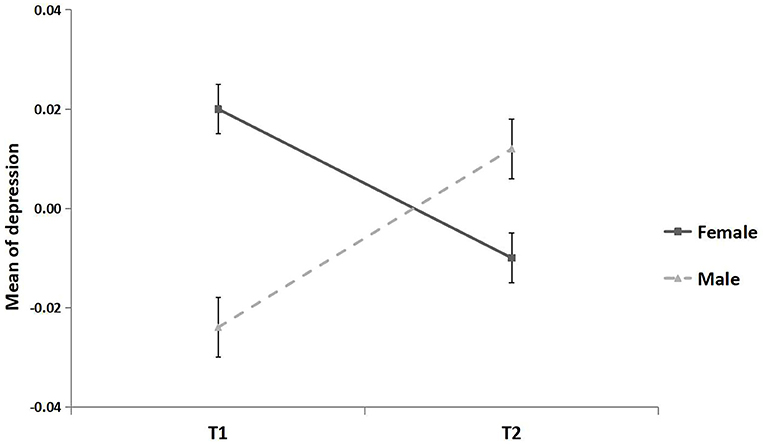
Figure 8. Mean of depression for females and males. All continuous variables were standardized. Error bar is the standard error.
We used logistic regression to assess the effects of T1 anxiety, T1 depression, epidemic level of the area, economic-related variables, and gender on T2 depression (Table 5). T1 anxiety (profile 1: no anxiety = 0; profile 2: anxiety = 1), T1 depression (profile 1: no depression = 0; type 2: depression = 1), T2 depression (profile 1: no depression = 0; profile 2: depression = 1), the gender (male = 1, female = 0), and epidemic area (comparing Level 1 vs. Level 3 [Level 1_3]: Level 1 = 1, level 3 = 0; comparing Level 2 vs. Level 3 [Level 2_3]: Level 2 = 1, Level 3 = 0) were dummy coded. The regression was significant, [F(8, 14760) = 66.48, p < 0.001, R2 = 0.035]. As shown in Table 4, the regression coefficients of T1 depression (β = 0.126, t = 13.15, p < 0.001), T1 anxiety (β = 0.068, t = 6.64, p < 0.001) and per capita consumption (β = −0.026, t = −5.02, p < 0.001) were significant.
Discussion
Through measures of anxiety and depression both before and after the pandemic outbreak, we found that the prevalence of university students with anxiety and depression symptoms above the standardized threshold increased 2.62 and 20.63%, respectively, to 4.06 and 22.09%. Furthermore, the increases in anxiety and depression were significantly moderated by both the severity level of the COVID-19 pandemic of the province where they lived and with their gender. In line with the Typhoon Eye effect, students living in areas with the least cases reported the greatest increase in anxiety and depression. In a second major finding, men's anxiety and depression increased more than women's during the lockdown.
The significant increase in the prevalence of both anxiety and depression symptoms were consistent with our expectations regarding the impact of the COVID-19 outbreak on university students' mental health. Other researchers have found that anxiety and depression have been heightened during the pandemic, particularly among quarantined individuals (Tang et al., 2020; Wang Y. et al., 2020). The shift to remote learning may have been especially challenging for university students, as living in a dorm has been found to be a protective factor for mental health problems (Eisenberg et al., 2007). In line with research showing the negative effects of reduced social support on alcohol abuse during remote learning (Lechner et al., 2020), removing students from this important source of social support may have exacerbated the effect of the pandemic on college students' mental health. The latent profile analysis additionally showed that it was the most vulnerable students—those who reported higher levels of anxiety and depression at time 1—who showed the greatest increases in these symptoms during remote learning.
The current study breaks new ground in examining how the severity of the pandemic in one's geographic region impacts students' anxiety and depression. Our results support the Psychological Typhoon Eye effect in that individuals' mental state in the areas with the highest epidemic level—the eye of the storm–was relatively calm (Li et al., 2010; Wang G. et al., 2020). This mechanism underlying this important finding should be examined by future research. Our study highlights a potential explanation for this seemingly paradoxical effect: individuals' perception of public and governmental support. For example, citizens living in high epidemic areas such as Wuhan received medical staff and facility support from all over China, whereas citizens in the low epidemic areas such as Tibet, Inner Mongolia, and Guangxi province may have perceived their medical support systems to be more vulnerable. This could dampen the level of anxiety and depression in high epidemic areas but exacerbate them in low epidemic areas (Xie et al., 2011; Zheng et al., 2015; Zhang et al., 2020). In our results, we see this in the negative relationship between the public healthcare budget in an area and citizens' levels of anxiety during the pandemic. Another mechanism that may explain the higher anxiety and depression outside the “eye” of the pandemic is the role of social media and news for university students. Consuming social media and news related to the pandemic has been found to worsen individuals' anxiety and depression (Gao et al., 2020; Li et al., 2020), whereas having direct experience with a hazard makes it appear less risky (Maderthaner et al., 1978). By studying the Typhoon Eye effect among a large sample of university students with pre-pandemic measures of anxiety and depression, the present study contributes important knowledge to a question that had previously shown contradictory results in the COVID-19 pandemic (Zhang et al., 2020; Zhao et al., 2020).
Gender has previously been identified as one of the predictive factors of mental health during the pandemic. In recent studies examining the general population, including individuals involved in retail, the service industry, and healthcare, women tended to be more likely to develop symptoms of anxiety and depression than men (e.g., Lei et al., 2020; Xiong et al., 2020). However, our results indicated that the increase in anxiety and depression during the lockdown was greater for male students than female students. We suggest two potential explanations for these findings. First, the switch to remote learning for university students during the lockdown means that students must live in a relatively closed environment with their parents while completing their online learning tasks, leading to parent-child conflict (Luo, 2020). Several lines of research indicate that male students experience more parent-child conflict than female students (Burt et al., 2006; Dotterer et al., 2008; Juang et al., 2012), and that parent-child conflict is associated with depression and anxiety (Marmorstein and Iacono, 2004; Lamis and Jahn, 2013). During the home quarantine, parent-child conflict and long-term exposure to adverse family emotional environments could be sources that caused the gender differences in mental health (Dunsmore and Halberstadt, 1997; Weymouth et al., 2016). A second potential explanation relates to gender differences in resiliency and coping. From an emotional coping perspective, a large number of previous studies have shown that men exhibit less expressive emotional behaviors than women (Barrett et al., 1998; Hess et al., 2000; Parkins, 2012; Chaplin and Aldao, 2013). Compared with men, women report more emotion-focused coping methods, including venting, emotional expression, and seeking social support (Billings and Moos, 1984; Ptacek et al., 1994), which may have enabled female students to adapt to the stressful environment more effectively (Cohen, 2004). Within the Chinese culture, males are also expected to exhibit greater expressive suppression than females (Cheng et al., 2009; Flynn et al., 2010; Zhao et al., 2014). Although expressive suppression can reduce the expression of negative emotions, it can have negative effects on cognition and emotion and is not an effective approach to emotion regulation (Gross and Levenson, 1997; Richards and Gross, 2000). Future research should explore how parent-child conflict and emotional suppression/expression differentially impacts male and female university students' coping with stress. The present findings imply that decisions to shut universities (to shift to remote learning e.g., in times of crisis) may be particularly harmful for male university students' mental health.
There are also important practical implications of the present work, which could be applied by universities and mental health counselors. The present study indicated that the pandemic has a negative impact on the anxiety and depression symptoms of university students, especially for male students and students who are not directly exposed to the highest levels of the epidemic. During the pandemic, university students showed a high level of interest in receiving psychological knowledge and interventions, especially for information that could help them alleviate negative psychological effects (Wang Z. et al., 2020). As adaptability has been identified as a key factor in protecting students from anxiety and depression during the Covid-19 pandemic (Zhang et al., 2021), fostering psychological flexibility could be a beneficial approach to addressing the negative consequences of pandemic on mental health (Kashdan and Rottenberg, 2010). Psychological flexibility is defined as the capacity to adapt one's behavior in a manner that incorporates conscious and open contact with thoughts and feelings (Scott et al., 2014). In the context of the pandemic, recent research has demonstrated that psychological flexibility plays a moderating role in the effects of the lockdown, relating to better mental health in a wide range of contexts, and that inflexibility is a risk factor for anxiety and depression (Hayes et al., 2006; Pakenham et al., 2020). This indicates that government, university, and mental health counselors should pay more attention to students with symptoms of anxiety and depression, as well as their related cognitive issues. It also essential for authorities to provide psychological knowledge, such as common symptoms of anxiety and depression, methods for alleviating negative psychological effects, and contact information for counseling services, to university students. Our findings highlight the increased burden of remote learning for the mental health of certain individuals (e.g., male students, students with pre-existing symptoms of anxiety and depression, and residents of areas with lower epidemic levels and healthcare budgets), which should be taken into account as well.
There are some limitations of the current study. First, data collection was completed by online research with self-report scales, which may limit the objectivity of the data. Second, although the university students came from more than 34 provinces, they all came from China, so the generalizability to populations in other cultures should be made with caution. Future research should replicate this model in other regions of the world. Third, in order to avoid carry-over effects and potential boredom from survey repetition, our participants completed two different measures of anxiety and depression at the two time points. Although both sets of measurements are highly reliable and validated by previous research (e.g., Liu et al., 2021), it can be problematic when studies use different measurements to measure the same construct (e.g., Feuer et al., 1999). However, based on recommendations to calculate outcome variables based on a common metric (Marcoulides and Grimm, 2017), we applied the standardized values of these two measurements (e.g., Ayubi et al., 2021). We acknowledge, however, that this was a limiting factor for our conclusions.
Conclusion
The present longitudinal study investigated the changes in the mental health status of college students in mainland China during the epidemic of COVID-19. The findings confirmed a significant increase in anxiety and depression among students. Results suggested that the increase of anxiety and depression was related to gender, pre-existing levels of anxiety and depression, and the severity of the epidemic in their geographic region.
Data Availability Statement
The datasets presented in this study can be found in online repositories. The names of the repository/repositories and accession number(s) can be found below: https://osf.io/64aw7/?view_only=fc4a64aca2a7481a866434d7da631a9d.
Ethics Statement
The studies involving human participants were reviewed and approved by Qingdao University. Written informed consent to participate in this study was provided by the participants' legal guardian/next of kin.
Author Contributions
SW and KZ: conceived and designed the survey, performed the survey, and contributed materials/analysis tools. KZ and ZH: analyzed the data. SW, KZ, EP-S, ZH, YJ, and XC: wrote the paper. KZ, EP-S, ZH, YJ, and XC: literature research. All authors contributed to the article and approved the submitted version.
Funding
This work was supported by the [Shandong Social Science Foundation] under Grant [21DSHJ03], and [Adolescent Development Research Project of the Central Committee of the Communist Young League] under Grant [20ZD017] awarded to KZ.
Conflict of Interest
The authors declare that the research was conducted in the absence of any commercial or financial relationships that could be construed as a potential conflict of interest.
References
Ahmed, M. Z., Ahmed, O., Aibao, Z., Hanbin, S., Siyu, L., and Ahmad, A. (2020). Epidemic of COVID-19 in China and associated psychological problems. Asian J. Psychiatry 51:102092. doi: 10.1016/j.ajp.2020.102092
Akaike, H. (1987). Factor analysis and AIC. Psychometrika 52, 317235–317332. doi: 10.1007/BF02294359
Ayubi, E., Bashirian, S., and Khazaei, S. (2021). Depression and anxiety among patients with cancer during COVID-19 pandemic: a systematic review and meta-analysis. J. Gastrointest. Cancer 52, 499–507. doi: 10.1007/s12029-021-00643-9
Barrett, L. F., Robin, L., Pietromonaco, P. R., and Eyssell, K. M. (1998). Are women the “more emotional” sex? evidence from emotional experiences in social context. Cogn. Emot. 12, 555–578. doi: 10.1080/026999398379565
Ben-Ezra, M., Sun, S., Hou, W. K., and Goodwin, R. (2020). The association of being in quarantine and related COVID-19 recommended and non-recommended behaviors with psychological distress in Chinese population. J. Affect. Disord. 275, 66–68. doi: 10.1016/j.jad.2020.06.026
Billings, A. G., and Moos, R. H. (1984). Coping, stress, and social resources among adults with unipolar depression. J. Pers. Soc. Psychol. 46:877. doi: 10.1037/0022-3514.46.4.877
Brooks, S. K., Webster, R. K., Smith, L. E., Woodland, L., Wessely, S., Greenberg, N., et al. (2020). The psychological impact of quarantine and how to reduce it: rapid review of the evidence. Lancet 395, 912–920. doi: 10.1016/S0140-6736(20)30460-8
Burt, S. A., McGue, M., Iacono, W. G., and Krueger, R. F. (2006). Differential parent-child relationships and adolescent externalizing symptoms: cross-lagged analyses within a monozygotic twin differences design. Dev. Psychol. 42:1289. doi: 10.1037/0012-1649.42.6.1289
Chang, J., Yuan, Y., and Wang, D. (2020). Mental health status and its influencing factors among college students during the epidemic of COVID-19. J. South Med. Univ. (Chinese) 40, 171–176. doi: 10.12122/j.issn.1673-4254.2020.02.06
Chaplin, T. M., and Aldao, A. (2013). Gender differences in emotion expression in children: a meta-analytic review. Psychol. Bull. 139:735. doi: 10.1037/a0030737
Cheng, L., Yyan, J. J., He, Y. Y., and Li, H. (2009). Emotion regulation strategies: cognitive reappraisal is more effective than expressive suppression. Adv. Psychol. Sci. 17:730.
Chi, X., Becker, B., Yu, Q., Willeit, P., Jiao, C., Huang, L., et al. (2020). Prevalence and psychosocial correlates of mental health outcomes among Chinese college students during the coronavirus disease (COVID-19) pandemic. Front. Psychiatry 11:803. doi: 10.3389/fpsyt.2020.00803
Cohen, S. (2004). Social relationships and health. Am. Psychol. 59:676. doi: 10.1037/0003-066X.59.8.676
Cucinotta, D., and Vanelli, M. (2020). WHO declares COVID-19 a pandemic. Acta Biomed. 91, 157–160. doi: 10.23750/abm.v91i1.9397
Derogatis, L. R., Lipman, R. S., and Covi, L. (1973). SCL-90: an outpatient psychiatric rating scale–preliminary report. Psychopharmacol. Bull. 9, 13–28.
Dotterer, A. M., Hoffman, L., Crouter, A. C., and McHale, S. M. (2008). A longitudinal examination of the bidirectional links between academic achievement and parent–adolescent conflict. J. Fam. Issues 29, 762–779. doi: 10.1177/0192513X07309454
Duan, L., Shao, X., Wang, Y., Huang, Y., Miao, J., Yang, X., et al. (2020). An investigation of mental health status of children and adolescents in china during the outbreak of COVID-19. J. Affect. Disord. 275, 112–118. doi: 10.1016/j.jad.2020.06.029
Dunsmore, J. C., and Halberstadt, A. G. (1997). How does family emotional expressiveness affect children's schemas? New Dir. Child Dev. 1997, 45–68. doi: 10.1002/cd.23219977704
Eisenberg, D., Gollust, S. E., Golberstein, E., and Hefner, J. L. (2007). Prevalence and correlates of depression, anxiety, and suicidality among university students. Am. J. Orthopsychiatry 77, 534–542. doi: 10.1037/0002-9432.77.4.534
Elbay, R. Y., Kurtulmuş, A., Arpacioglu, S., and Karadere, E. (2020). Depression, anxiety, stress levels of physicians, and associated factors in Covid-19 pandemics. Psychiatry Res. 290:113130. doi: 10.1016/j.psychres.2020.113130
Felger, J. C., Haroon, E., and Miller, A. H. (2015). Risk and resilience: animal models shed light on the pivotal role of inflammation in individual differences in stress-induced depression. Biol. Psychiatry 78, 7–9. doi: 10.1016/j.biopsych.2015.04.017
Feuer, M. J., Holland, P. W., Green, B. F., Bertenthal, M. W., and Hemphill, F. C. (1999). Uncommon Measures: Equivalence and Linkage among Educational Tests. Washington, DC: National Academy Press.
Flynn, J. J., Hollenstein, T., and Mackey, A. (2010). The effect of suppressing and not accepting emotions on depressive symptoms: is suppression different for men and women? Pers. Individ. Dif. 49, 582–586. doi: 10.1016/j.paid.2010.05.022
Gao, J., Zheng, P., Jia, Y., Chen, H., Mao, Y., Chen, S., et al. (2020). Mental health problems and social media exposure during COVID-19 outbreak. PLoS ONE 15:e0231924. doi: 10.1371/journal.pone.0231924
Gross, J. J., and Levenson, R. W. (1997). Hiding feelings: the acute effects of inhibiting negative and positive emotion. J. Abnorm. Psychol. 106:95. doi: 10.1037/0021-843X.106.1.95
Hayes, S. C., Luoma, J. B., Bond, F. W., Masuda, A., and Lillis, J. (2006). Acceptance and commitment therapy: model, processes and outcomes. Behav. Res. Ther. 44, 1–25. doi: 10.1016/j.brat.2005.06.006
Hess, U., Senécal, S., Kirouac, G., Herrera, P., Philippot, P., and Kleck, R. E. (2000). Emotional expressivity in men and women: stereotypes and self-perceptions. Cogn. Emot. 14, 609–642. doi: 10.1080/02699930050117648
Ho, C. S. H., Chee, C. Y., and Ho, R. C. M. (2020). Mental health strategies to combat the psychological impact of coronavirus disease (COVID-19) beyond paranoia and panic. Ann. Acad. Med. Singap. 49, 155–160. doi: 10.47102/annals-acadmedsg.202043
Hodges, J. L. (1958). The significance probability of the Smirnov two-sample test. Ark. Mat. 3, 469–486. doi: 10.1007/BF02589501
Holmes, E. A., O'Connor, R. C., Perry, V. H., Tracey, I., Wessely, S., Arseneault, L., et al. (2020). Multidisciplinary research priorities for the COVID-19 pandemic: a call for action for mental health science. Lancet Psychiatry 7, 547–560. doi: 10.1016/S2215-0366(20)30168-1
Hoven, C. W., Duarte, C. S., Lucas, C. P., Wu, P., Mandell, D. J., Goodwin, R. D., et al. (2005). Psychopathology among New York City public school children 6 months after September 11. Arch. Gen. Psychiatry 62, 545–551. doi: 10.1001/archpsyc.62.5.545
Juang, L. P., Syed, M., and Cookston, J. T. (2012). Acculturation-based and everyday parent–adolescent conflict among Chinese American adolescents: longitudinal trajectories and implications for mental health. J. Fam. Psychol. 26:916. doi: 10.1037/a0030057
Kashdan, T. B., and Rottenberg, J. (2010). Psychological flexibility as a fundamental aspect of health. Clin. Psychol. Rev. 30, 865–878. doi: 10.1016/j.cpr.2010.03.001
Lamis, D. A., and Jahn, D. R. (2013). Parent–child conflict and suicide rumination in college students: the mediating roles of depressive symptoms and anxiety sensitivity. J. Am. Coll. Health. 61, 106–113. doi: 10.1080/07448481.2012.754758
Lechner, W. V., Laurene, K. R., Patel, S., Anderson, M., Grega, C., and Kenne, D. R. (2020). Changes in alcohol use as a function of psychological distress and social support following COVID-19 related university closings. Addict. Behav. 110:106527. doi: 10.1016/j.addbeh.2020.106527
Lei, L., Huang, X., Zhang, S., Yang, J., Yang, L., and Xu, M. (2020). Comparison of prevalence and associated factors of anxiety and depression among people affected by versus people unaffected by quarantine during the covid-19 epidemic in southwestern China. Med. Sci. Monit. 26:e924609. doi: 10.12659/MSM.924609
Li, J., Yang, Z., Qiu, H., Wang, Y., Jian, L., Ji, J., et al. (2020). Anxiety and depression among general population in China at the peak of the COVID-19 epidemic. World Psychiatry 19, 249–250. doi: 10.1002/wps.20758
Li, S., Rao, L.-L., Ren, X.-P., Bai, X.-W., Zheng, R., Li, J.-Z., et al. (2009). Psychological typhoon eye in the 2008 Wenchuan earthquake. PLoS ONE 4:e4964. doi: 10.1371/journal.pone.0004964
Li, S., Rao, L. L., Bai, X. W., Zheng, R., Ren, X. P., Li, J. Z., et al. (2010). Progression of the “psychological typhoon eye” and variations since the Wenchuan earthquake. PLoS ONE 3:e9727. doi: 10.1371/journal.pone.0009727
Liu, D., Baumeister, R. F., and Zhou, Y. (2021). Mental health outcomes of coronavirus infection survivors: a rapid meta-analysis. J. Psychiatr. Res. 137, 542–553. doi: 10.1016/j.jpsychires.2020.10.015
Luo, R. (2020). Relationship between social isolation and parent-child conflicts of college students during COVID-19. J. Wenzhou Polytech. 20, 21–25. doi: 10.13669/j.cnki.33-1276/z.2020.041
Maderthaner, R., Guttmann, G., Swaton, E., and Otway, H. J. (1978). Effect of distance upon risk perception. J. Appl. Psychol. 63:380. doi: 10.1037/0021-9010.63.3.380
Marcoulides, K. M., and Grimm, K. J. (2017). Data integration approaches to Longitudinal Growth Modeling. Educ. Psychol. Meas. 77, 971–989. doi: 10.1177/0013164416664117
Marmorstein, N. R., and Iacono, W. G. (2004). Major depression and conduct disorder in youth: associations with parental psychopathology and parent–child conflict. J. Child Psychol. Psychiatry 45, 377–386. doi: 10.1111/j.1469-7610.2004.00228.x
Mazza, M. G., De Lorenzo, R., Conte, C., Poletti, S., Vai, B., Bollettini, I., et al. (2020). Anxiety and depression in COVID-19 survivors: role of inflammatory and clinical predictors. Brain. Behav. Immun. 89, 594–600. doi: 10.1016/j.bbi.2020.07.037
Oxford, R. L. (2015). Ritual, depression and beyond, and on the death of Sophia. J. Poet. Ther. 28, 53–61. doi: 10.1080/08893675.2015.980064
Pakenham, K. I., Landi, G., Boccolini, G., Furlani, A., Grandi, S., and Tossani, E. (2020). The moderating roles of psychological flexibility and inflexibility on the mental health impacts of COVID-19 pandemic and lockdown in Italy. J. Contextual Behav. Sci. 17, 109–118. doi: 10.1016/j.jcbs.2020.07.003
Parkins, R. (2012). Gender and Emotional Expressiveness: An Analysis of Prosodic Features in Emotional Expression. Nathan, QLD; Griffith University.
Peng, M., Mo, B., Liu, Y., Xu, M., Song, X., Liu, L., et al. (2020). Prevalence, risk factors, and clinical correlates of depression in quarantined population during the COVID-19 outbreak. J. Affect. Disord. 275, 119–124. doi: 10.1016/j.jad.2020.06.035
Podsakoff, P. M., MacKenzie, S. B., Lee, J.-Y., and Podsakoff, N. P. (2003). Common method biases in behavioral research: a critical review of the literature and recommended remedies. J. Appl. Psychol. 88, 879–903. doi: 10.1037/0021-9010.88.5.879
Ptacek, J. T., Smith, R. E., and Dodge, K. L. (1994). Gender differences in coping with stress: when stressor and appraisals do not differ. Pers. Soc. Psychol. Bull. 20, 421–430. doi: 10.1177/0146167294204009
Richards, J. M., and Gross, J. J. (2000). Emotion regulation and memory: the cognitive costs of keeping one's cool. J. Pers. Soc. Psychol. 79:410. doi: 10.1037/0022-3514.79.3.410
Salari, N., Hosseinian-Far, A., Jalali, R., Vaisi-Raygani, A., Rasoulpoor, S., Mohammadi, M., et al. (2020). Prevalence of stress, anxiety, depression among the general population during the COVID-19 pandemic: a systematic review and meta-analysis. Glob. Health 16:57. doi: 10.1186/s12992-020-00589-w
Schwarz, G. (1978). Estimating the dimension of a model. Ann. Stat. 6, 461–464. doi: 10.1214/aos/1176344136
Scott, W., McCracken, L. M., and Trost, Z. (2014). A psychological flexibility conceptualisation of the experience of injustice among individuals with chronic pain. Br. J. Pain 8, 62–71. doi: 10.1177/2049463713514736
Tang, W., Hu, T., Hu, B., Jin, C., Wang, G., Xie, C., et al. (2020). Prevalence and correlates of PTSD and depressive symptoms one month after the outbreak of the COVID-19 epidemic in a sample of home-quarantined Chinese university students. J. Affect. Disord. 274, 1–7. doi: 10.1016/j.jad.2020.05.009
The Scipy Community (2020). SciPy Scipy v1.6.0 Reference Guide. Available online at: https://docs.scipy.org/doc/scipy/reference/generated/scipy.stats.kstest.html (accessed April 25, 2021).
Van Rheenen, T. E., Meyer, D., Neill, E., Phillipou, A., Tan, E. J., Toh, W. L., et al. (2020). Mental health status of individuals with a mood-disorder during the COVID-19 pandemic in Australia: initial results from the COLLATE project. J. Affect. Diord. 275, 69–77. doi: 10.1016/j.jad.2020.06.037
Wang, G., Zhang, Y., Xie, S., Wang, P., Lei, G., Bian, Y., et al. (2020). Psychological typhoon eye effect during the COVID-19 outbreak. Front. Public Health 8:883. doi: 10.3389/fpubh.2020.550051
Wang, Y., Wang, C., Liao, Z., Zhang, X., and Zhao, M. (2020). A comparative analysis of anxiety and depression level among people and epidemic characteristics between COVID-19 and SARS. Life Sci. Res. (Chinese) 24, 180–186. doi: 10.16605/j.cnki.1007-7847.2020.03.002
Wang, Z. (1984). The self-report symptom inventory, symptom checklist-90, SCL-90. Shanghai Arch. Psychiatry (Chinese) 2, 68–70.
Wang, Z., Yang, H., Yang, Y., Liu, D., Li, Z., Zhang, X., et al. (2020). Prevalence of anxiety and depression symptom, and the demands for psychological knowledge and interventions in college students during COVID-19 epidemic: a large cross-sectional study. J. Affect. Disord. 275, 188–193. doi: 10.1016/j.jad.2020.06.034
Weymouth, B. B., Buehler, C., Zhou, N., and Henson, R. A. (2016). A meta-analysis of parent–adolescent conflict: disagreement, hostility, and youth maladjustment. J. Fam. Theory Rev. 8, 95–112. doi: 10.1111/jftr.12126
Xie, X.-F., Stone, E., Zheng, R., and Zhang, R.-G. (2011). The “Typhoon eye effect”: determinants of distress during the SARS epidemic. J. Risk Res. 14, 1091–1107. doi: 10.1080/13669877.2011.571790
Xiong, J., Lipsitz, O., Nasri, F., Lui, L. M., Gill, H., Phan, L., et al. (2020). Impact of COVID-19 pandemic on mental health in the general population: a systematic review. J. Affect. Disord. 277, 55–64. doi: 10.1016/j.jad.2020.08.001
Xu, X., Ai, M., Hong, S., Wang, W., Chen, J., Zhang, Q., et al. (2020). The psychological status of 8817 hospital workers during COVID-19 epidemic: a cross-sectional study in Chongqing. J. Affect. Disord. 276, 555–561. doi: 10.1016/j.jad.2020.07.092
Ystgaard, M., Tambs, K., and Dalgard, O. S. (1999). Life stress, social support, and psychological distress in late adolescence: a longitudinal study. Soc. Psychiatry Psychiatr. Epidemiol. 34, 12–19. doi: 10.1007/s001270050106
Zhang, K., Wu, S., Xu, Y., Cao, W., Goetz, T., and Parks-Stamm, E. (2021). Adaptability promotes student engagement under COVID-19: the multiple mediating effects of academic emotion. Fron. Psychol. 11:3785. doi: 10.3389/fpsyg.2020.633265
Zhang, L., Ma, M., Li, D., and Xin, Z. (2020). The psychological typhoon eye effect during the COVID-19 outbreak in China: the role of coping efficacy and perceived threat. Glob. Health 16, 1–10. doi: 10.1186/s12992-020-00626-8
Zhao, H., He, X., Fan, G., Li, L., Huang, Q., Qiu, Q., et al. (2020). COVID-19 infection outbreak increases anxiety level of general public in China: involved mechanisms and influencing factors. J. Affect. Disord. 276, 446–452. doi: 10.1016/j.jad.2020.07.085
Zhao, X., Zhang, R., and Zheng, K. (2014). Gender differences in emotion regulation strategies in adolescents. Chin. J. Clin. Psychol. 22, 849–854. doi: 10.16128/j.cnki.1005-3611.2014.05.067
Zheng, R., Rao, L.-L., Zheng, X.-L., Cai, C., Wei, Z.-H., Xuan, Y.-H., et al. (2015). The more involved in lead-zinc mining risk the less frightened: a psychological typhoon eye perspective. J. Environ. Psychol. 44, 126–134. doi: 10.1016/j.jenvp.2015.10.002
Zhu, J., Sun, L., Zhang, L., Wang, H., Fan, A., Yang, B., et al. (2020). Prevalence and influencing factors of anxiety and depression symptoms in the first-line medical staff fighting against COVID-19 in Gansu. Front. Psychiatry 11:386. doi: 10.3389/fpsyt.2020.00386
Zung, W. W. K. (1965). A self-rating depression scale. Arch. Gen. Psychiatry 12, 63–70. doi: 10.1001/archpsyc.1965.01720310065008
Keywords: COVID-19, anxiety, depression, university students, longitudinal study
Citation: Wu S, Zhang K, Parks-Stamm EJ, Hu Z, Ji Y and Cui X (2021) Increases in Anxiety and Depression During COVID-19: A Large Longitudinal Study From China. Front. Psychol. 12:706601. doi: 10.3389/fpsyg.2021.706601
Received: 07 May 2021; Accepted: 11 June 2021;
Published: 06 July 2021.
Edited by:
Valentina Lucia La Rosa, University of Catania, ItalyReviewed by:
Simona Trip, University of Oradea, RomaniaDušana Šakan, Faculty of Legal and Business Studies Dr Lazar Vrtakić, Serbia
Copyright © 2021 Wu, Zhang, Parks-Stamm, Hu, Ji and Cui. This is an open-access article distributed under the terms of the Creative Commons Attribution License (CC BY). The use, distribution or reproduction in other forums is permitted, provided the original author(s) and the copyright owner(s) are credited and that the original publication in this journal is cited, in accordance with accepted academic practice. No use, distribution or reproduction is permitted which does not comply with these terms.
*Correspondence: Keshun Zhang, a2VzaHVuLnpoYW5nQHFkdS5lZHUuY24=
 Shizhen Wu1
Shizhen Wu1 Keshun Zhang
Keshun Zhang Elizabeth J. Parks-Stamm
Elizabeth J. Parks-Stamm Zhonghui Hu
Zhonghui Hu Yaqi Ji
Yaqi Ji Xinxin Cui
Xinxin Cui